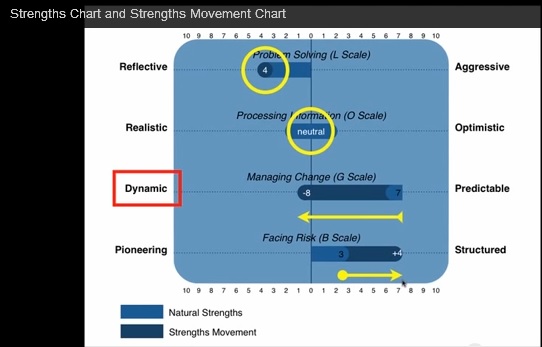Where Do You Cross the Line?
The Strengths Movement Chart is an element included in your Leading From Your Strengths profile report (or your Marriage Insights profile report.) It is visual representation of your natural strengths with an overlay of your adapted strengths in four predictable areas: problem solving, processing information, managing change, facing risk.
Adapted strength scores, like natural strengths scores, are numeric. They indicate the behavior you allow others to see – your “mask” – even when that behavior may not be most natural to you.
Amounts indicate show how much you adjust or compensate your natural strengths to match the requirements of a specific environment, such as your work, your family, or your ministry. The overlay on the chart reveals the amount of movement you make to adjust in each of the four areas, as compared with your natural strengths.
Most important to note is that strengths movement scores are not a judgment, but rather simply provide information. The scores allow you to discover how you are using your strengths in a certain environment. You can use this information to chart a path to using your strengths more productively.
These are questions users ask most often about the Strengths Movement Chart.
FAQ #1: What kinds of strengths movement scores are shown on the chart?
 The Strengths Movement Chart shows each of the 4 predictable areas. Your natural strengths scores (medium blue) are overlayed with your adapted strengths scores, indicating strengths movement (dark blue).
The Strengths Movement Chart shows each of the 4 predictable areas. Your natural strengths scores (medium blue) are overlayed with your adapted strengths scores, indicating strengths movement (dark blue).
The chart indicates three kinds of adapted strengths scores.
- Neutral score: indicated by a circle on the overlay
- Positive score: indicated with a “+” on the scores overlay
- Negative score: indicated with a “-“ on the overlay
FAQ #2: Do the amounts of movements have significance?
The amount of movement in each of the four areas reveals how much you feel you need to adjust or compensate your natural strengths to match the requirements of your environment. Strengths movements over 5 points, whether positive or negative, indicate a significant need to adapt. Give these scores special attention.
FAQ #3: What creates a neutral score?
A neutral score, indicated by a circle on the overlay (see the top two scales in the image), shows that you are using your natural strengths in the most productive ways in your current environment.
FAQ #4: What creates movement in a positive direction?
Your adaptive strength in one or more of the four areas, when overlaid onto your natural strength in that area, may show a positive number (for example, “+4” on the lowest scale of the image). Positive movement shows you are using your strengths in that area – and your environment or people you work with may challenge you to use even more of it. The adaptations you make to use more of your strengths may take some energy, but not the significant amount required when you must use a strength that doesn’t come naturally to you. A positive score can be a positive stimulant, in that it allows you to develop your natural strengths.
FAQ #5: What creates movement in a negative direction?
Your adaptive strength in one or more of the four areas, when overlaid onto your natural strength in that area, may show a negative number (for example, “-8” in the image’s third scale from the top). When your adaptive strength score moves in the direction opposite to your natural strength score, you find you must use a strength that is not natural to you. Negative movement on a scale, particularly with a score of 5 or more or a score that crosses the energy line, indicates your environment requires you to use strengths that don’t come naturally to you. You may experience conflict in the environment or be asked to be something you are not. While challenges can helps you stretch and grow, you may also want to consider that the adaptation may be causing you excessive frustration or stress.
FAQ #6: What kinds of conflict lead to a significant number movement?
Number movement scores can indicate three types of conflict:
- Me-You conflict: an interpersonal conflict between you and another individual whose strengths differ from yours.
- Me-Job conflict: a vocational conflict. Here, your position requires strengths that are different from yours.
- Me-Me conflict: an internal struggle with yourself, found most often among those who have low self-esteem. No matter what strengths you have, a Me-Me conflict means you perceive your strengths are not good enough,
FAQ #7: How can I use this information?
As you study your Strengths Movement Chart, ask yourself these three questions:
- What kinds of movements do I find in the four predictable areas?
Study where scores show you have neutral movement, positive movement, or negative movement. Make special note of areas in which movement is 5 points or higher (regardless of whether it is positive or negative.) These scores indicate areas in which you are making considerable adaptations. - Where do I cross the line?
Note any areas in which your adapted strengths scores cross the energy line into the opposite strength. This shows areas in which you may expend considerable energy to adapt. Determine if your adaptation is Me-You, Me-Job, or Me-Me. - Should I take any action based on what I learned?
Study the information you have gathered to consider changes you may want to make to reduce stress, curb your frustration, and maximize your strengths. Share your conclusions with your spouse, a trusted friend, or a certified practitioner to make an action plan.
You can also learn more about using the Strengths Movement Chart in this short training video.
More FAQs: Frequently Asked Questions
FAQs: How to Customize Your Communication with People Who Have Other Strengths
FAQs: Report Consolidation Template – Your Profile on One Page
FAQs: Tight Patterns and Neutral Graphs
